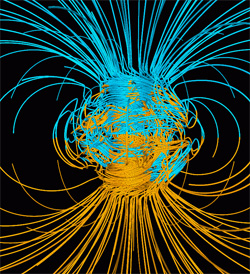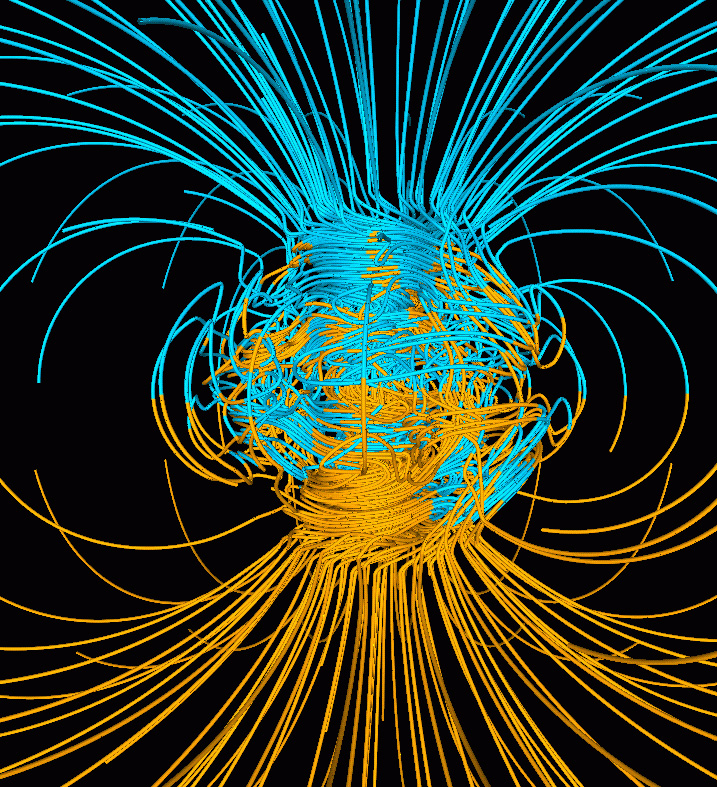Liquid Magnet: Stirred, not Shaken
The Earth, Sun, and other astronomical bodies generate magnetic fields through the churning motion of internal fluids that conduct electricity. These fluids are often highly turbulent, but in the 29 April Physical Review Letters a team shows progress toward generating magnetism in a smoothly flowing fluid, using a carefully-rotated tank of liquid sodium. They report an eight-fold amplification of a “seed” field, but they can’t demonstrate a self-sustaining field until the next phase of the project. The work may lead to a better understanding of the importance of turbulence in generating magnetic fields in stars and planets.
In the last decade, researchers have succeeded in creating magnetic fields in the lab with so-called fluid dynamos. Like their astronomical counterparts, these systems are based on the rotation of a fluid, typically sodium, because it has a high conductivity. A small initial magnetic field applied to the rotating tank can generate electric current, which generates more magnetic field, so that a positive feedback loop develops that can lead to exponential field growth, if the flow is right. Rather than discussing the complex current-field interactions, researchers often describe the amplification as a process of stretching and folding of magnetic field lines, which are essentially entrained by the fluid.
Early examples of these dynamos channeled the flow in a pre-determined pattern (Focus, 5 May 2000). More recent designs allowed the fluid to flow freely in a tank while being agitated by propeller-like fans. In 2007, one of these collaborations reported a working dynamo that its designers claimed depended upon turbulent eddies to generate the required feedback (Focus, 30 January 2007). However, others have questioned this interpretation [1]. The argument against a turbulent-induced dynamo is that turbulence is random–some of the eddies will give the necessary positive feedback, but others will dilute, or diffuse, the field by spreading it out. Moreover, turbulence may be suppressed in nature by fluid friction, such as the viscosity in the molten core of the Earth, argues Stirling Colgate of Los Alamos National Laboratory in New Mexico.
Colgate and his colleagues want to see if they can take turbulence out of the picture. The goal of their alpha-Omega dynamo experiment at the New Mexico Institute of Mining and Technology in Socorro is to create a smooth, coherent flow in liquid sodium. The fluid is inside a 30-centimeter-tall, ring-shaped tank, whose inner radius is half the outer radius. The team rotates the fluid by turning the cylindrical walls of the tank, rather than by using propellers. The inner wall rotates at 68 revolutions per second, while the outer wall rotates one-fourth as fast. The smooth rotational flow is representative of fluid dynamos within young stars and around black holes, says Colgate.
In their latest experiments, the team applied a seed magnetic field of about 12 gauss that pointed radially inward. As expected for a conductive fluid, the sodium “grabbed” the magnetic field lines and wound them around the ring-shaped tank, like a child wrapping herself up in a telephone cord. This wrapping and stretching, which is called the Omega effect, created a magnetic field in the direction of the fluid flow that was as much as eight times the seed field.
But the Omega effect is not enough for a self-sustaining field. To complete the dynamo, the team needs to bend some of the amplified field back in the original radial direction. This can be done by the so-called alpha effect, which results from helical fluid motion. Turbulence, with its swirling eddies, is a natural source of helical motion, but Colgate’s group hopes to create a smooth alpha effect by sending plumes of fluid up from the bottom of the rotating tank.
“The important physics message is that laminar flows can produce large scale magnetic fields more easily than turbulent flows,” says Cary Forest of the University of Wisconsin, Madison, who works on another dynamo experiment. But Forest says that turbulence has been observed in the dynamos of the Sun and the Galaxy. Another dynamo researcher, Jean-François Pinton of the École Normale Supérieure of Lyon, says that turbulence may creep into all dynamos: “Turbulence is not the best friend of the dynamo, but my feeling is that it’s unavoidable.”
–Michael Schirber
Michael Schirber is a Corresponding Editor for Physics Magazine based in Lyon, France.
References
- R. Laguerre, C. Nore, A. Ribeiro, J. Léorat, J.-L. Guermond, and F. Plunian, “Impact of Impellers on the Axisymmetric Magnetic Mode in the VKS2 Dynamo Experiment,” Phys. Rev. Lett. 101, 104501 (2008)
More Information
Stirring Up a Magnetic Field (Focus, 5 May 2000)
Molten Metal Magnet (Focus, 30 January 2007)





